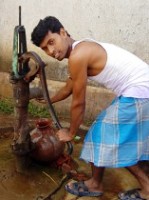
Team Offers Solutions to Arsenic-contaminated Water in Southern Asia
On the May 28 issue of the journal Science, researchers from Stanford University, the University of Delaware, and Columbia University review what scientists understand about arsenic contamination of groundwater and offer solutions for spans Bangladesh, Cambodia, China, India, Myanmar, Nepal, Pakistan, and Vietnam.

This is a typical hand-pump tubewell in a rural village in West Bengal, India, where there also is arsenic. Photo by Holly Michael, University of Delaware.
Holly Michael, assistant professor of geological sciences in the College of Earth, Ocean, and Environment at the University of Delaware, is a co-author of the article with Scott Fendorf from Stanford and Alexander van Geen from Columbia University. Fendorf is chair of environmental and Earth system science at Stanford.
Michael traveled to Bangladesh to study the groundwater contamination problem during her postdoctoral training with the U.S. Geological Survey.
The source of South Asia's arsenic contamination is the Himalaya Mountains. Minerals from rocks, eroding coal seams, and sediments contain arsenic and are carried into the major rivers that flow out of the mountains, including the Indus, Ganges, Brahmaputra, Irawaddy, Meghna, Mekong, and Red rivers. The flat, low-lying floodplains of these major rivers are affected by groundwater contamination.
Deeper wells would access uncontaminated aquifers for drinking water, but farmers also want to use this water to irrigate rice paddies. And that's a problem, according to Michael's research.
In 2008, Michael showed through numerical modeling of groundwater flow in the Bengal Basin that an uncontaminated domestic well more than 500 feet (150 meters) could remain arsenic-free for at least 1,000 years. However, she projected an entirely different scenario for deep irrigation wells, which use mechanized pumps instead of hand pumps to bring groundwater to the surface. The high volumes of water drawn by these irrigation systems induced a much faster downward migration of arsenic-contaminated surface water into the deep aquifer.
“To protect drinking water from arsenic contamination, we recommend that deeper wells only be used by individual households for drinking water and not for crop irrigation,” Michael says.
In addition to preserving deep wells specifically for drinking water, she and her co-authors also recommend:
- reinvigorating well-testing campaigns by governments and international organizations;
- better use of existing geological data and the compilation of test results to target zones that are low in arsenic for the installation of community wells;
- re-testing of tens of thousands of deep wells, particularly those that have been used for both domestic and farming purposes; and
- the choice of mitigation option can be situation-dependent: filters or other alternatives may be the best choice in some areas.
Currently, Michael is working to model arsenic transport, how it may move in the future in the aquifer system in Bangladesh. She also is working with the World Bank on a study of groundwater sustainability in Bangladesh related to water supply and vulnerability of coastal groundwater to sea-level rise.